Solar power has been the Next Big Thing for decades now, yet it remains a niche player in the energy world. The problem of intermittency is unsolved, up-front capital costs remain high, and surging demand for polysilicon, a key component of solar panels, has recently outstripped supply, stifling production.

Travis Bradford.
So when someone claims that within decades solar photovoltaic technology will come to dominate the world’s energy portfolio — with or without subsidies, with or without rising fossil-fuel prices, with or without new environmental legislation — one could be forgiven a degree of skepticism.
But Travis Bradford is no hippie idealist. The author of Solar Revolution: The Economic Transformation of the Global Energy Industry spent the early years of his career in corporate acquisitions and private equity funds — not fields that reward irrational exuberance. His book is based on research and analyses done at his Massachusetts think tank, the Prometheus Institute for Sustainable Development, working from what he claims are conservative assumptions about market and capital trends.
Those trends, he says, are inexorable: Just as revolutions have transformed the information and communication sectors, solar power will break the hold of sclerotic, centralized power companies.
Your book’s central claim is pretty bold.
Thanks for recognizing that.
It’s not just that we’re moving toward alternatives, it’s that we’re moving toward distributed [power generation] as well. If both of those are true, solar is the only viable option.
Solar is different from other energy technologies in that it delivers energy at the point of use, directly to the end user. That allows it to circumvent the entire supply chain. It’s not another option for a utility, it’s a competitor to a utility — the first time utilities have really had a competitor.
The best way to describe it is with an anecdote about cell phones. We used to have these monopoly telephone infrastructure players. They controlled everything, and they had all the processing power at central switching stations. You had these dummy terminals that you just picked up; you had a connection, but no brains. All the brains were in the center of the network. And then these cell-phone producers came along and, in the Telecommunications Act of ’96, were given access to the telephone grid. They began to go completely around the supply chain and offer competing services to the same customers, wireless and easier. The telephone utilities … first they ignored it, then they tried to fight it legislatively, and when they lost that they tried to fight it economically. Eventually they just decided, screw it, we’re going to buy them. Today those are the most profitable parts of their business. That’s the transformation.
This also happened in computers. We went from large, centralized mainframes with dummy terminals to a distributed hybrid architecture.
Solar is slowly going to begin to unwind the existing utility economics, to the point where utilities decide they have to get in or they risk losing their core business — exactly the transformations we’ve lived through in the last 20 years.
The solar revolution does not require new breakthroughs in technology. You could do it with the technology we have, scaling it up and learning how to do it incrementally better every year — which is what naturally happens with scale.
Solar is mainly used for electricity, which represents just over a third of energy use. How do you account for transportation fuels?
We’ll never solve the problem of transportation until we reconnect the transportation and electricity infrastructures. There’s not enough liquid fuels.
I’m not a big fan of biofuels — on close examination their environmental impact is wretched. What it does is export part of our energy price for transportation through the grocery store, right? We end up subsidizing the cost of our transportation infrastructure in the price of food stocks. Biofuels will solve some problems, but at the end of the day there’s not enough land in the entire Mississippi River Valley to meet our transportation needs. And then where would we get food from? There’s cellulosic, but that’s only another 10 percent.
There are real capacity constraints in any transportation-fuel option until we reconnect it with the electricity infrastructure. You do that either with plug-in hybrids or with electrolyzed hydrogen. My guess is that batteries will be better for transportation purposes, and electrolyzed hydrogen for stationary applications, because fuel cells on site are much easier to make than fuel cells with the thrust needed in automobiles.
Other than industrial processes, we use thermal applications in heating and hot water. There are electric analogs to both of them. We can have electric hot water heaters just as easily as gas hot water heaters. We can have electric home heating. Historically it was believed that thermal applications were about a third the price of electricity-based heating applications, but that was based on $2 per thousand cubic-foot natural gas and whatever the prevailing price of electricity was. These have come a whole lot more in parity, and in a lot of places in the world, electric heat’s the way they go.
Everything has to reconnect. The infrastructures that separated — first at the beginning of the century, and again in the middle of the century for natural-gas infrastructure — have to reconnect. And we’ll need a lot more electricity to drive that.
A lot more. What do you do about coal?
Coal is the enemy of the human race.
There’s my pull quote. Do you think solar’s going to beat coal?
Solar’s going to change the electricity infrastructure in a way that will make coal unnecessary. This distributed architecture is going to get to the point where wind and geothermal, where available, take over a lot of the baseload needs; solar will meet a lot of the peak needs, and some of the base needs during the day. The combination of these portfolios will make coal irrelevant. Wind and thermal are nearly as cheap as coal, if not cheaper, and coal still enjoys tremendous subsidies. Under certain circumstances nuclear power would be OK, but I highly doubt those circumstances can be met.
Solar is a universal system available inversely with the wealth of the nation. The richest countries have less and the poorest countries have more.

The best and the brightest?
Photo: iStockphoto
What about areas that get little sunlight — like, say, Seattle?
The sun is shining, just not as brightly here as it is in the desert. Seattle gets about half the sun of Los Angeles, for instance.
Historically, the cost of solar drops about 5 to 6 percent per annum, just based on the volume of growth and natural learning. If that continues — and I use even more conservative estimates than that, showing the learning rates slow down a little bit — you get to the point that solar in Seattle is cost-effective 10 years later than solar in Los Angeles. Ten years is not a very long time in terms of energy infrastructure. It’s the blink of an eye, when you’re thinking about planning and zoning.
Solar’s taking off right now in Germany and Japan, which have as little sun as Seattle. It’s taken off because of some good political will; they’ve ended up subsidizing renewables as much as they’ve subsidized existing fossil-fuels infrastructure. They’ve leveled the playing field a little bit better than we have.
Solar’s not going to be the only solution. It’s going to be part — a surprisingly large part — of a portfolio of solutions. Its limits are not a problem we’re going to have to deal with for at least two or three decades. By the time we reach a point where solar’s problems might be binding, we’ll already have a set of options to deal with them — storage solutions will be three decades ahead. By that time we’re generating a quarter of our energy on solar anyway.
A good problem to have.
Exactly.
It’s always the supply side that gets press and attention, but utilities and utility regulations are a bottleneck. What’s going to happen grid-wise?
Deregulation has allowed utilities to squeeze their spare capacity. They’ve been able to reconfigure assets and put off upgrading their infrastructure. The grid today is deeply underinvested in. So it’s getting frailer — that’s what the blackout in Brooklyn this summer was all about. The upgrades are too expensive; they can’t afford it under the current rate structures.
The grid infrastructure is problematic, but distributed solutions help solve that. The utilities have already been moving toward distributed natural-gas plants. Solar provides a great alternative for utilities that don’t want to invest in line extensions and upgrades. Ultimately utility providers are going to figure out that they want this hybrid infrastructure. They’ll get to a point where they’re participating in and pushing the process rather than ignoring or resisting it.
I’ve talked to a number of senior managers and board members at utilities around the country. One of them — a board member of a Northeastern utility — said to me, “We don’t know what to do, but the writing’s on the wall, and the conversation is occurring at the board level at every utility around the country: How do we migrate our systems to a renewable, distributed system?” The conversations are being had, but these are slow-moving entities.
Bush’s Asia-Pacific climate pact is a trade deal to facilitate U.S. nuclear and coal industries selling their older technologies in the developing world. There’s a rush to build up traditional electricity infrastructure in the developing world. Will it succeed?
They’re going to be successful in some places. But the reality is that grid infrastructures are not economic in low-density, low-income nations. If they were anywhere close to economic they would have been built already. You’ll have integrated policy environments like China, where they’ve got 96 percent grid electrification and lots of coal. But in the vast majority of the under-electrified or non-electrified countries, solar’s already the cheapest option.
It’s frequently said that the U.S. is falling behind in 21st-century energy industries. Is it true?
I often claim that we are in danger of trading our addiction to Middle Eastern oil and Russian natural gas for an addiction to Chinese polysilicon and solar cells. That is a risk.
But if you look at where the materials come from for the solar industry today, while a lot of the cells are made in Germany and Japan and a few in China, a majority of the silicon they use comes from the United States. We’re shipping them the feed stocks, and we’re making a tremendous amount of money doing it. That’s where all the profit is in the supply chain right now, because of the shortage.
The U.S. has lost the glamorous parts of the supply chain. But the profitable and the potentially path-breaking parts like thin-film solar are still here. If we don’t get in the game, those will go away, too. We are at risk of losing those, but right now we actually have a pretty strong position, at least in solar.
Are you a “crash and contraction are inevitable” environmentalist or an Amory Lovins-style techno-optimist?
I am definitely in the latter family. The way I characterize those two schools of thought are the defense school and the offense school. The defense school is filling the sandbags — they think we have passed the point of no return, so their strategies to cope are defense-based strategies. My deepest concern is that the defense crowd is right. But I’m not ready to play defense yet.
If we’re going to solve the problem, the solar revolution is a necessary and significant component of the solution.
If.
We all live with what we believe to be true and what we fear to be true.
Will the decentralization of power production be accompanied by a decentralization of political power?
Solar power is empowering. All things being equal, people like to control the resources upon which they rely. That’s why I spend time thinking about solar technologies rather than centralized, easily controlled technologies. At the end of the day, sustainability includes distributed power and democratization.



